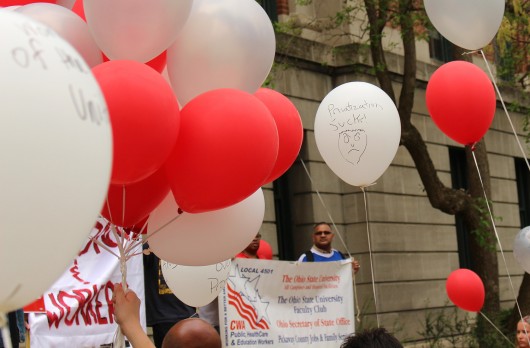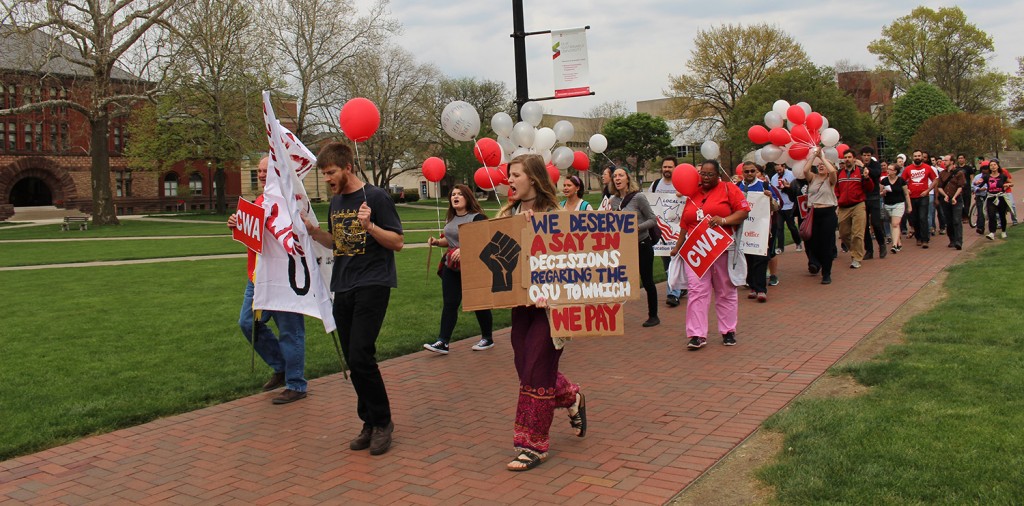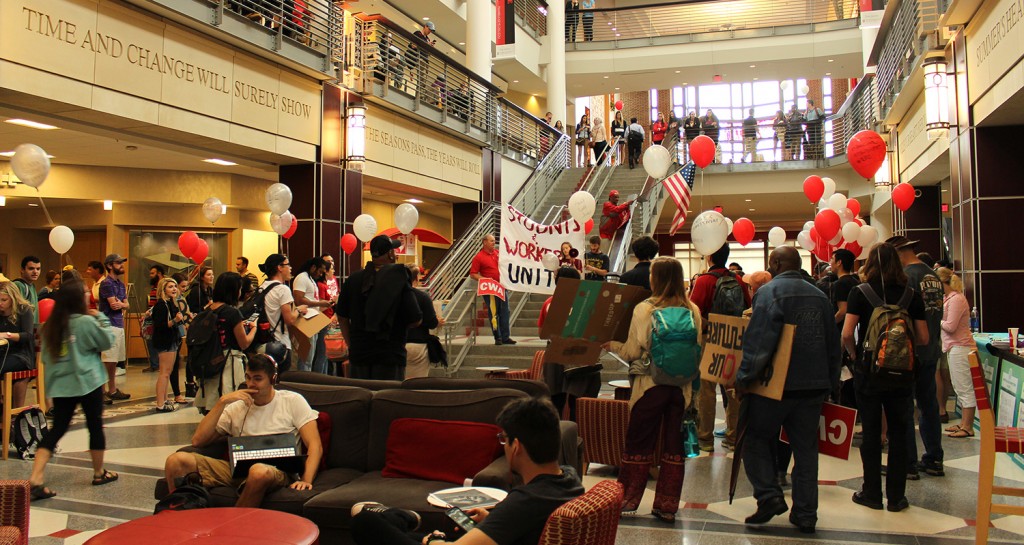
Jed DeBruin, communications director of United Students Against Sweatshops, speaks to the crowd about the energy plan. Credit: Hannah Herner | Assistant Arts&Life Editor
Ohio State students and activists gathered in protest at Bricker Hall for the second time in as many weeks Thursday afternoon.
However, this time around, they were met with University Police guarding several of the locked doors of Bricker Hall, which houses the office of University President Michael Drake.
The group was protesting the proposal of the university’s Comprehensive Energy Management Project, which would create a partnership between the university and a private group to manage and operate OSU’s energy systems at the Columbus campus.
A university police officer said that only employees were being admitted entrance on Thursday. University spokesman Chris Davey said he would not confirm if the restricted access to Bricker Hall was because of the anticipation of protesting students.
“For a brief time we have placed limited restrictions on Bricker Hall access out of an abundance of caution to ensure the operations of the university continue uninterrupted,” he said in an email. “Anyone with scheduled business in Bricker Hall is welcome.”
Bricker Hall was put under restricted access for several days after #ReclaimOSU student protesters staged a sit-in in the building on April 6. The students’ demands included greater transparency and access to information regarding OSU’s budget and investments.
Michelle Hablitzel, president of the OSU United Students Against Sweatshops and a fifth-year in geography and international studies, said she wasn’t surprised the building was locked on Thursday, given the publicity of the rally but was surprised by the potentially perceived threat students posed.
“The fact that they see us as a threat is surprising to me,” she said. “I don’t know what they think we’re going to do. What are they scared of? We’re peaceful protesters. This is civil disobedience.”
Jay Kasey, senior vice president for administration and planning, told students sitting in Bricker Hall on April 6 that university leaders decided the presence of the students in the building might scare employees working the following day.
Thursday’s protesters began marching from the South Oval at about 3:30 p.m. They then made their way to the Ohio Union and, finally, to Bricker Hall to tie some balloons to the doors of the hall and drop off a letter of discontent to Drake. The balloons had messages that opposed the energy plan written on them.

Protesters wrote complaints regarding the Comprehensive Energy Management Project on balloons and brought them to Bricker Hall. Credit: Hannah Herner | Assistant Arts&Life Editor
The march was organized by USAS, and it was joined by members of the Local 4501 union chapter of the Communications Workers of America as well as several other student organizations.
Hablitzel said that by meeting at Bricker Hall, the group was trying to send a message to Drake that it opposes the energy management plan, which is currently in its third phase.
“We do not think it will be beneficial to the people that this university exists to serve, which is the students, the workers,” she said. “This is a land-grant institution, so it’s supposed to contribute to the well-being of the community. I think faculty budgets will be compromised with this deal, which will then compromise the educational mission of our university.”
According to the OSU website, any partner would be required to interview utilities employees affected by the energy project. And, the university has made a commitment that utilities staff members will be offered a position at OSU at a salary equivalent to that staff members’ current position.
Kevin Kee, president of CWA Local 4501, said his group was concerned about employee wages and the retirement of utilities employees.
“We are here fighting for democracy, good clean jobs, our retirement,” Kee said. “Ohio State is the largest employer in Central Ohio, 38,000 employees. If they are allowed to destroy the public workforce, that will but a huge dent in the public retirement system. The retirement system that I count on.”
Jed DeBruin, communications director of USAS and a third-year in geography, said he was also concerned about current employees and accountability regarding how a private firm might make a profit, as part of the partnership.
“OSU is a land-grant institution. It is obligated to be committed to the community. For me, committed means keeping unionized workers unionized in the same jobs they were hired in in the first place,” DeBruin said. “It’s great that the workers are guaranteed OSU jobs, but this only came as a result of students and workers rising up. OSU workers in the utility systems are still only guaranteed an interview in their current position and will lose their crucial union status.”
Pranav Jani, associate professor in the Department of English who also spoke at Bricker Hall, saying the he felt it was important that supportive faculty members stood with student protesters.
“They have a comprehensive energy plan. What we have to have is a comprehensive resistance, a comprehensive fight-back,” he said. “Not just one single issue, not just one organization. Yeah, we know to get things done you have to focus, we know that. But we are not driven by one single issue.”







